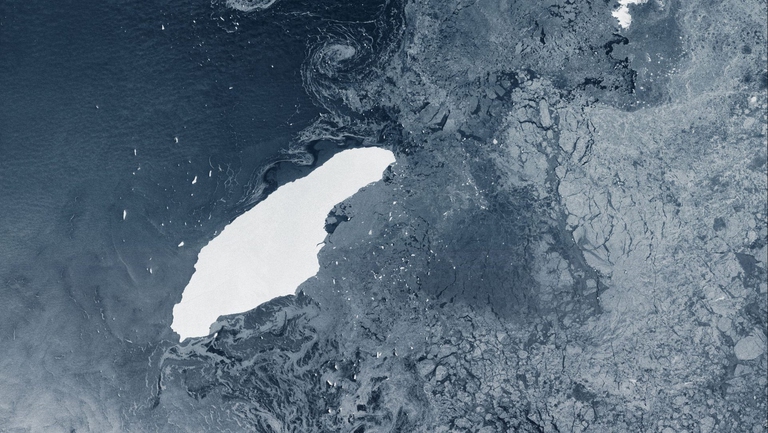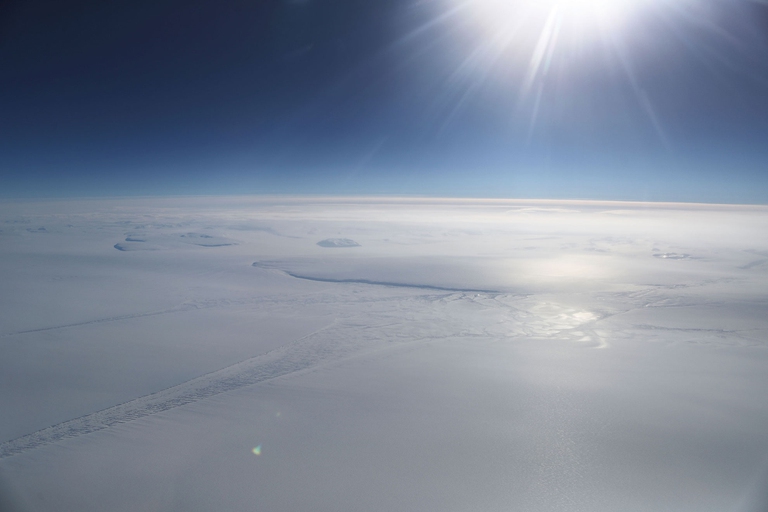
The extent of sea ice in Antarctica reached a new record low on 21st February 2023.
In 2017 the world’s largest iceberg, known as A68, detached from the Larsen C ice shelf and began drifting along the ocean. Today, it has almost entirely melted away.
The A68 iceberg has melted. Its journey began in 2017 when it broke away from the Larsen C ice shelf in Antarctica. At the time, it was considered the largest iceberg in the world, its surface extending for almost six thousand square kilometres – that’s more than the whole of Brunei – with a mass of over one billion tonnes. Today, satellite images show that today, after a long journey, A68 has almost completely melted away. The iceberg has broken up into smaller fragments which, according to the US National Ice Centre, it isn’t even worth monitoring.
For a while, A68 didn’t really move much. It then began heading northwards and, at the end of last year, it reached a speed of one kilometre per hour. It had even entered into a collision course with the island of South Georgia, a British territory in the southern Atlantic ocean. Many icebergs end up melting in this region due to local shallows.
However, it wasn’t the shallows that stopped A68. According to the BBC, it was the waves and higher water and air temperatures in the Atlantic that consumed it, causing it to disintegrate into many pieces. “It’s amazing that A68 lasted as long as it did,” said Swansea University Professor Adrian Luckman. “If you think about the thickness ratio – it’s like four pieces of A4 paper stacked up on top of one another. So this thing is incredibly flexible and fragile as it moved around the ocean. It lasted for years like that. But it eventually broke into four-to-five pieces and then those broke up as well.”
The US National Ice Centre, whose role is to monitor icebergs and determine which ones constitute a risk for shipping, decided to cease monitoring A68. Its fragments are now smaller than the standard required to be classed as dangerous.
In 2017, soon after A68 broke off from Larsen C, glaciologists from Midas (a British research project) stated that this was a natural event, not necessarily linked to anthropogenic global warming. This hypothesis seems to still stand to this day, despite the fact that all experts agree that this process nonetheless leads to a series of risks for the world’s ice cover, as it makes the ice increasingly unstable. In any case, A68’s journey has come to an end.
Siamo anche su WhatsApp. Segui il canale ufficiale LifeGate per restare aggiornata, aggiornato sulle ultime notizie e sulle nostre attività.
![]()
Quest'opera è distribuita con Licenza Creative Commons Attribuzione - Non commerciale - Non opere derivate 4.0 Internazionale.
The extent of sea ice in Antarctica reached a new record low on 21st February 2023.
It finally broke off. The iceberg A68, twice the size of Luxemburg, is no longer part of Antarctica’s Larsen C ice shelf, which could also collapse.
National Geographic photographer Paul Nicklen has opened his first gallery in the city of New York, United States. It focuses on animals, the environment and the risks they both face due to climate change through images shot in diverse areas of the world including the Arctic and Antarctica. I’m taking over the @pewenvironment account this week, starting today on
South African court dismisses a major lawsuit by 140,000 Zambian women and children against Anglo American for Kabwe lead poisoning. A setback for affected communities enduring the lasting impact of lead contamination.
Controversial African land deals by Blue Carbon face skepticism regarding their environmental impact and doubts about the company’s track record, raising concerns about potential divergence from authentic environmental initiatives.
Majuli, the world’s largest river island in Assam State of India is quickly disappearing into the Brahmaputra river due to soil erosion.
The Arctic is registering an unusual winter this year. While temperatures hit a new record in November, it is now sea ice cover to have recorded its lowest extent at a time when it should be at its maximum extent. In January 2017 the ice cover was 13.38 million square kilometres, the lowest extent in almost
In 40 years, the Arctic will run out of ice during summer months, as proven by the lowest icecap winter extension ever registered by satellites last March. It is a phenomenon involving half of the Arctic ice. These are some of the effects caused by the on-going climate change, documented by WWF in
Antarctica, otherwise known as the sixth continent, recorded an increase of 70% in the rate of shrinking over the last decade (1994-2003). The thickness of ice shelves in the South Pole is thinner and thinner, and it could even halve within 200 years. The research containing the data was published by Science magazine,









